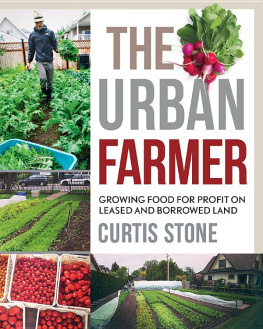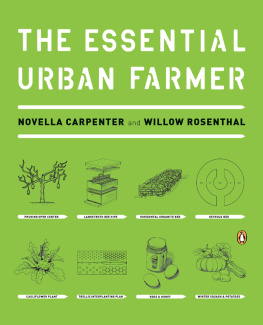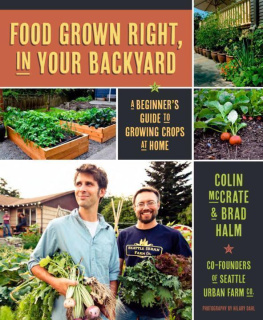
backyard roots



backyard roots
lessons on living local from

urban farmers


Copyright 2013 by Lori Eanes
All rights reserved. No part of this book may be reproduced or utilized in any form, or by any electronic, mechanical, or other means, without the prior written permission of the publisher.
Published by Skipstone, an imprint of The Mountaineers Books
Printed in China
First printing 2013
16 15 14 13 5 4 3 2 1
Copy Editor: Sherri Schultz
Design: Jane Jeszeck / www.jigsawseattle.com
Cover photograph: Lori Eanes
All photographs by the author unless otherwise noted
Page 2: Tara Hui in her San Francisco backyard; pages 45: Chef Leather Storrs in his restaurants rooftop garden in Portland, Oregon; page 6: Freshly harvested raspberries from Farm Saeturns P-Patch plot in Seattle, Washington
ISBN (paperback): 978-1-59485-711-9
ISBN (ebook): 978-1-59485-712-6
Library of Congress Cataloging-in-Publication Data on file
Skipstone books may be purchased for corporate, educational, or other promotional sales. For special discounts and information, contact our sales department at 800-553-4453 or .
Skipstone
1001 SW Klickitat Way
Suite 201
Seattle, Washington 98134
206.223.6303
www.skipstonebooks.org
www.mountaineersbooks.org

Contents


Kenya Spiegel and Seth Brown built their goat barn almost entirely from recycled materials. The siding, for example, was made from old flooring that a Portland neighbor was throwing away.

introduction
finding backyard inspiration
AS A FOOD PHOTOGRAPHER, Ive taken pictures of all kinds of foods: drippy, sugary, grilled, sauted, tossed, and frozen. Whatever the subject, my job is always the same: to make it look delicious. Its got to jump off the page and stop you in your tracks. I spend so much time looking at food that I cant help but be a little obsessed about it. I wonder whats in it, where it came from, how it was grown, and even who grew it.
Curious about the food industry, I started reading books about it, such as Fast Food Nation, The Omnivores Dilemma, and Food Politics. They opened my eyes to the ugly side of pretty food. I read about animals kept in horrible conditions, poisonous pesticides, and monoculture on a massive scale. The state of industrial agriculture depressed me, and it seemed a growing number of people felt the same way I did. The idea of eating foods grown locally and without pesticides was taking root, and some people were taking it a step furtherturning their yards into backyard farms.
The project that eventually grew into this book started with an idea: find these urban farmers and see what they were up to. I had just read Farm City, Novella Carpenters adventure in urban farming, and I had heard about other urban farmers. I was curious. I wondered who these people were and how they did it. How did they grow their own food and raise farm animals in the city?
I started in my own backyard: the Bay Area. In San Francisco, houses are packed together and space is a rarity, yet still I found farmers. As I worked my way up the West Coast to Vancouver, British Columbia, I found the movement wasnt limited to where I live. All kinds of people are involved with urban farming, from scrappy fighters willing to take on outdated legislation, to a young cancer survivor working with elderly immigrants at a community garden, to a couple who challenged themselves to grow all their own food for a year or buy it locally.
Although my original idea was just to take photographs, as I learned peoples stories their dedication inspired me to write about them too. I loved hearing about their real-life experiences, and I found such a diversity of farmers and approaches that I was always surprised. And the farmers not only recounted their stories but also generously shared practical tips with me.
Some of the people profiled in this book have worked to change outdated laws, thus making urban farming more accessible to all. Barbara Palermos two-year odyssey to legalize backyard chickens in Salem, Oregon, was fascinating, and her dedication was amazing. She went so far as to learn filmmaking in order to make a documentary, which garnered the public support needed to change the law. Equally inspiring were Caitlyn Galloway and Brooke Budner, who started growing vegetables in an empty lot in San Francisco, began to sell their produce part-time, and then were forced to overturn a law in order to become the first legal small commercial farm within city limits.
I also met pioneers experimenting with innovative ideas, like Jodi Peters, who started an aquaponics project in Vancouver, British Columbia. Through her I vicariously experienced the trials and tribulations of learning to set up a barrel system to grow vegetables and raise tilapia. I also met people who keep their culture alive through their gardens, like Farm Saeturn, who immigrated to Seattle from Laos but continues to practice her traditional farming methods.
Some of these urban farmers have figured out ways to make a living from their passion, like Krista and David Arias, who started an urban farm stay in Portland, Oregon. The couple converted their large historic home into rooms for travelers looking to experience an urban farm. They had so much success that they turned it into a business. Or Joan Engelmeyer, who incorporates her urban farm into the art classes for kids that she teaches on the farm in Seattle. She recently started raising goats for wool and now teaches felting to her students.
In my own backyard, I discovered that growing food isnt hard, and its creative and satisfying too. Its really a miracle that a seed can sprout in the dirt and, with a little luck, produce food so tasty that it may not last long enough to make the trip to the kitchen. As a photographer, Ive found that urban farming has made food even more interesting to me. I love the imperfections, textures, and colors of the heirloom varieties that you can find only at farmers markets or grow yourself.




















